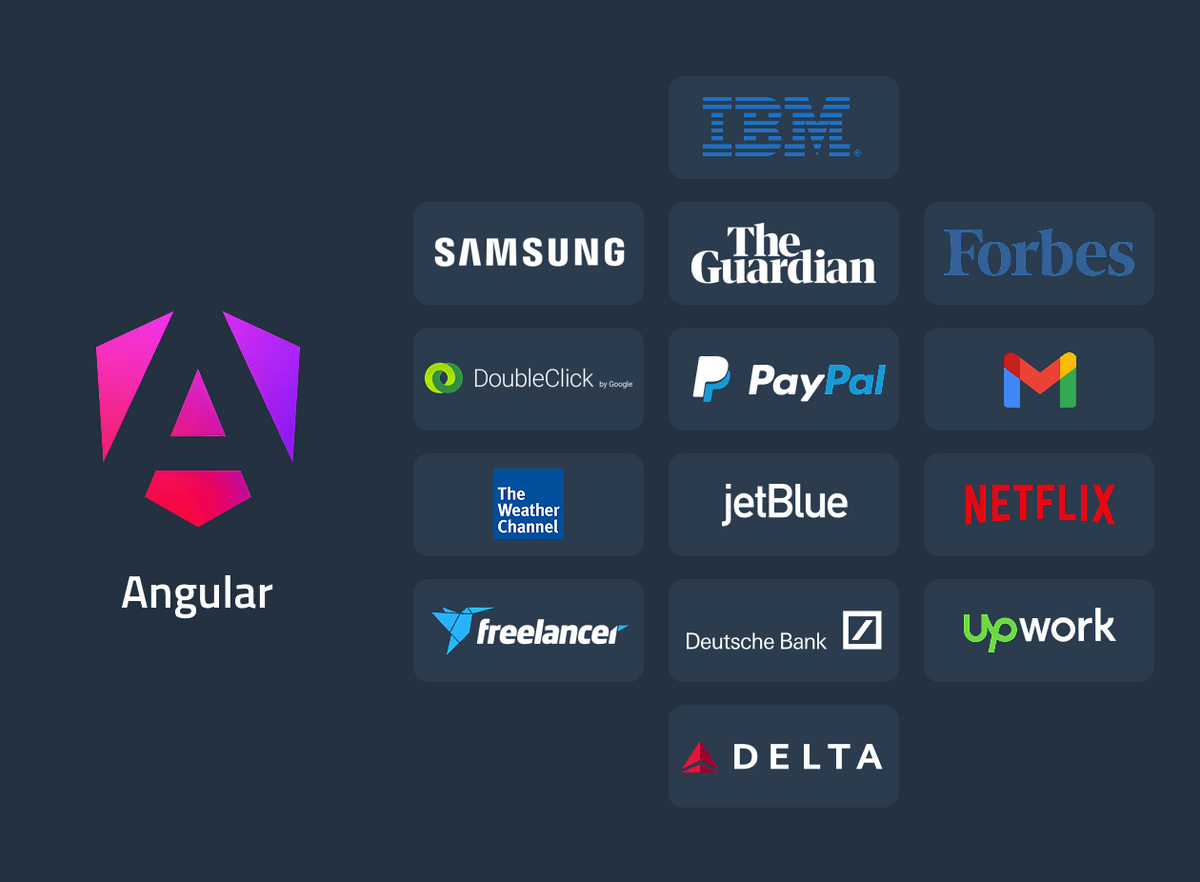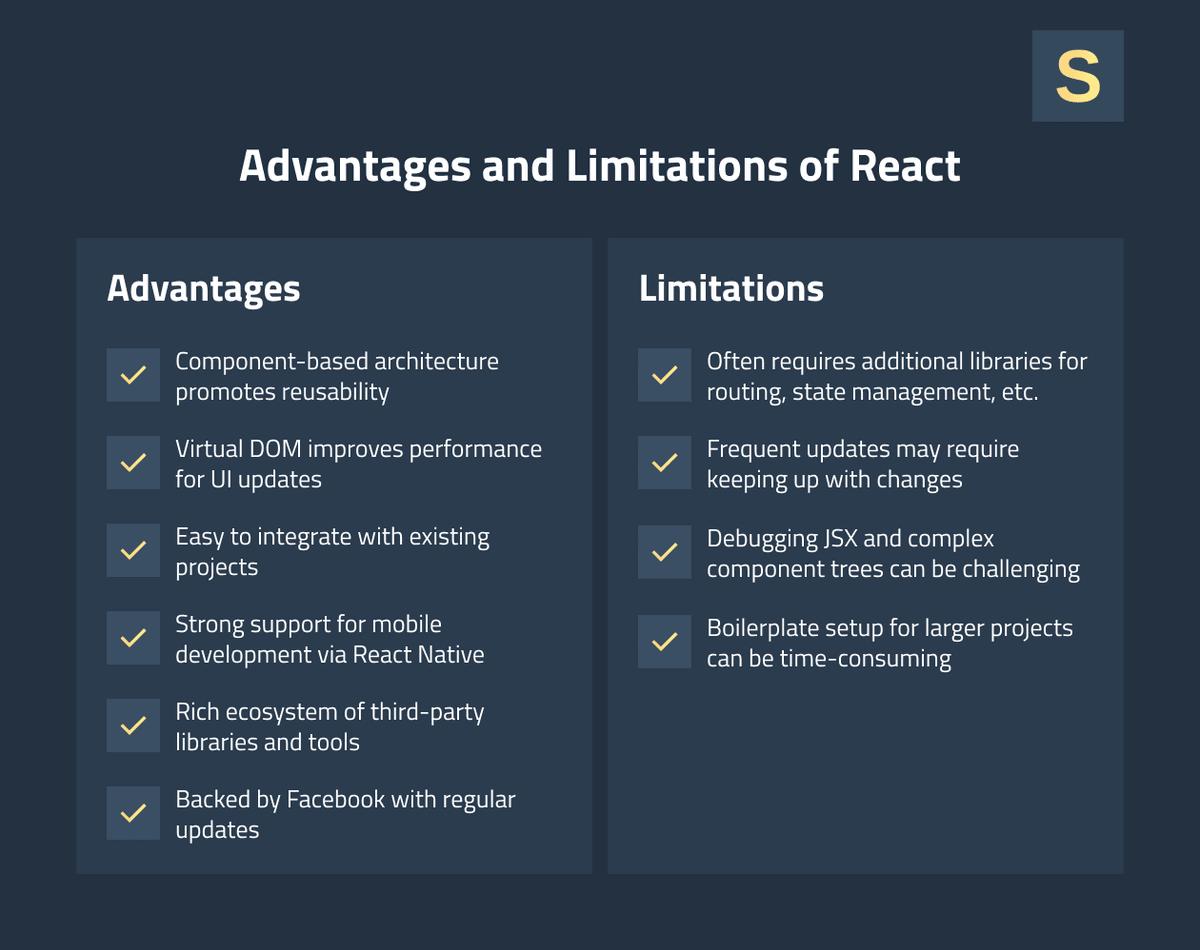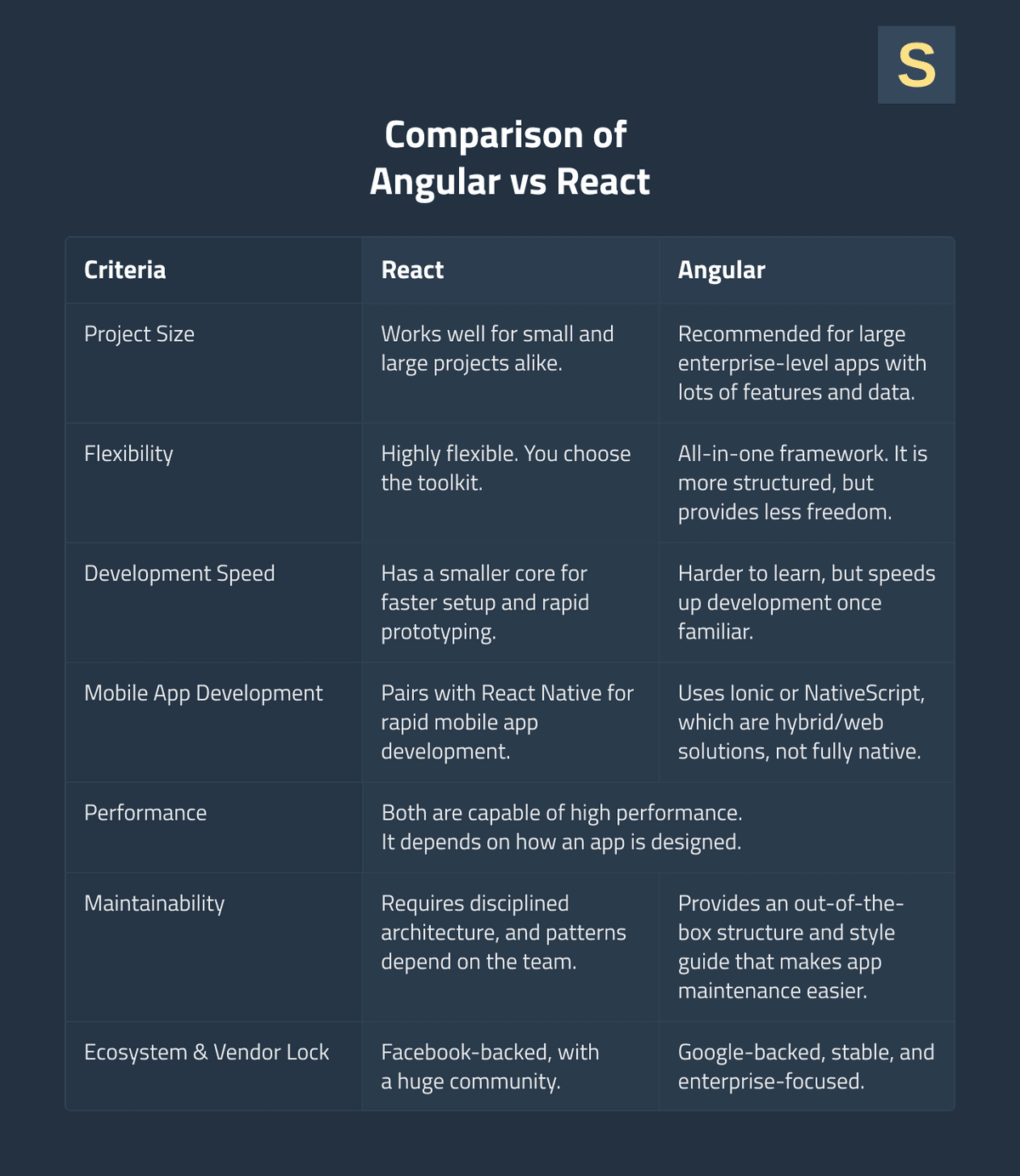Business leaders often fear choosing the wrong tech stack. You need technology that enables you to launch quickly and stay scalable in the long run. When it comes to web projects, choosing between React and Angular is a common decision.
With 8+ years of experience in web development, we understand these pain points ourselves. In this article, we are going to share our experience with React vs. Angular to help you make the right decision.
Here, you’ll find answers to questions like:
- What are the advantages of Angular and React?
- What are the limitations of these technologies?
- For which projects are Angular and React most suitable?
React vs. Angular: General Overview
Angular and React both enable powerful web applications. Still, they have different philosophies that drive their usage.
Angular is a full-fledged TypeScript-based framework with many built-in features for web development, like routing, forms, DI, etc.
React is a library used to build UI in JavaScript/JSX that relies on additional libraries for handling state, routing, and other features.
Let’s dive deeper into how each technology works to understand its strengths and weaknesses.
Advantages and Disadvantages of Angular

If you ask "What are the advantages of Angular?", the answer is that they include faster development of enterprise patterns and robust documentation.
As a full-featured framework, Angular provides many out-of-the-box advantages to companies. Its component architecture promotes reusability and consistency. TypeScript at its core, provides static typing, early error-checking, and better tooling for large teams.
Common needs are solved out of the box by Angular's official features, such as:
- CLI;
- AOT compilation;
- Dependency injection;
- RxJS.
These features speed up the development of complex applications.
Other Angular advantages include strong performance tools. Lazy loading and tree-shaking via Ivy decrease the bundle size while server-side rendering via Angular Universal improves SEO. Angular features such as a full-fledged CLI and official libraries enforce conventions and make app structure easier. Integrated tools and a straightforward upgrade path make it a great choice for enterprise applications.
From a business perspective, Angular reduces reliance on third-party vendors as it’s fully maintained by Google. It provides an enterprise-level structure that many corporate and government projects appreciate. Teams can follow the Angular style guide and find seasoned Angular developers. The rich module system makes scaling easier because one can easily split large applications into feature modules and lazy-load them to improve performance.
The flip side is that Angular's completeness comes with complexity. For instance, this framework has a steep learning curve since a developer must learn:
- TypeScript;
- Decorators;
- Modules;
- RxJS patterns.
This overhead slows down the first iterations for small startups and MVPs. Moreover, Angular code can be verbose; even simple UIs may require several classes or files, which means more boilerplate.
When to Use Angular Over React
Angular is best suited for large, long-lived projects where consistency and type safety matter the most. If you're building an enterprise dashboard, customer portal, or any system that needs built-in modules (forms, routing, HTTP) and a formal upgrade path, Angular can pay dividends. Also, it's smart to choose Angular if you already have TypeScript experts or your product benefits from strict conventions.
Verdict: Use Angular when your team requires an all-inclusive framework and seeks a single-vendor solution.
Real-World Examples of Angular Projects

Google (Gmail), PayPal, JetBlue, and others have trusted Angular with their high-traffic applications. These use cases include complex data flows, high-security needs, and guaranteed support for feature updates.
These examples show the strength of Angular in performance-critical, high scale applications.
Advantages and Disadvantages of React

React’s popularity stems from its simplicity and flexibility. It’s a lightweight UI library: learn the basics of JavaScript and JSX, and you're productive in no time. React uses a virtual DOM to update only what's needed, resulting in very fast, interactive user interfaces with minimal code.
Its component model fosters reuse and modular design. Because React is not opinionated about architecture, developers can pick best-fit libraries (Redux, MobX, React Router, etc.).
From a business perspective, React provides performance and SEO. With frameworks like Next.js or Gatsby, React applications can be server-side rendered or statically generated for improved load time and search indexing. React's huge ecosystem means a huge pool of UI libraries and open-source components that speed up development, such as:
- Charting libraries;
- Maps;
- UI toolkits.
Another big advantage is React Native. If a mobile app is on your roadmap, you can reuse React concepts to deliver iOS/Android apps fast.
The flip side of React's minimalism is that you need to assemble many pieces yourself. Core React doesn’t include form handling, HTTP, or even state management. You pick libraries for each of these. This freedom can result in fragmentation since each React project might use different solutions, and so codebases can vary widely.
It also changes frequently. "New syntax features, such as hooks, and updates to libraries or their versions require developers to stay up to date.
When to Use React Over Angular
React is ideal when you need to move quickly and stay flexible. It’s a great choice if you have a strong JavaScript team and want fine-grained control over libraries. Companies often prefer React because its large community and performance record offer peace of mind.
Verdict: Use React for small-to-medium projects, prototypes, or consumer-facing apps where speed matters the most.
Real-World Examples of React Projects

Dozens of major companies and projects use React today. The most obvious example is Facebook (which invented React), and its family of apps. Besides that, React projects include:
- Instagram;
- WhatsApp;
- Netflix;
- Airbnb;
- Uber;
- Uber Eats;
- Pinterest;
- Walmart.
At Seedium, we use React quite often in our projects. For example, we used this library to build SmarterContact, a real estate communications platform.
Angular vs React: How to Choose the Right Tech Stack for Your Project
Despite all the general benefits and limitations, you need to understand that each project is a unique case. The best idea is to define and prioritize the criteria that matter the most for your web application development.
Angular vs React: Performance
If we consider the performance of Angular vs React, it tends to be similar. Benchmarks show React often has slightly smaller bundles and faster initial load, but the gap is small. In business terms, either can be optimized for speed. In other words, performance usually depends more on application design and optimization than on the framework choice.
Angular vs React: Security
As for security, Angular has included built-in sanitization and stricter default patterns, while the simplicity of React means security relies more on developers following best practices. React offers basic protection through JSX escaping, but developers must handle advanced security manually.
Angular vs React: Scalability
Both frameworks provide good scalability. However, React requires more architectural planning as it often needs external libraries for state management, routing, and other features that are default in Angular.
Angular vs React: Maintainability
NGModules modularize features for ease of maintenance and growth because of the unique architecture of Angular. Its official CLI and release process (one vendor) means upgrades are coordinated and less likely to break things.
React maintainability depends heavily on team discipline, consistent architecture, and thoughtful use of libraries. It’s pretty easy to maintain small and medium projects, but large applications need planning and clear guidelines.
Angular vs React: Community and Resources
Both technologies have active communities, with React being slightly bigger. React has a larger talent pool, so it’s easier and faster to hire developers. Angular developers are more specialized, but often more experienced with enterprise-scale applications.
Angular vs React: Summary
In brief, Angular vs React advantages and disadvantages come down to whether you value flexibility and speed or built-in structure and stability. In fact, the most important aspect is which technology your team is most familiar with, because it is human expertise that gives technology its power.
Design, architecture, and other technical decisions made by experienced web developers will allow you to achieve your project goals regardless of the chosen framework.

At Seedium, we have 8+ years of experience in building scalable web apps using both React and Angular. We can help you choose and implement the right tech stack. You can turn to Seedium to build your product from scratch or augment your in-house team with dedicated developers.
Feel free to check out our web app development services to see how our engineers can help you with your projects.





